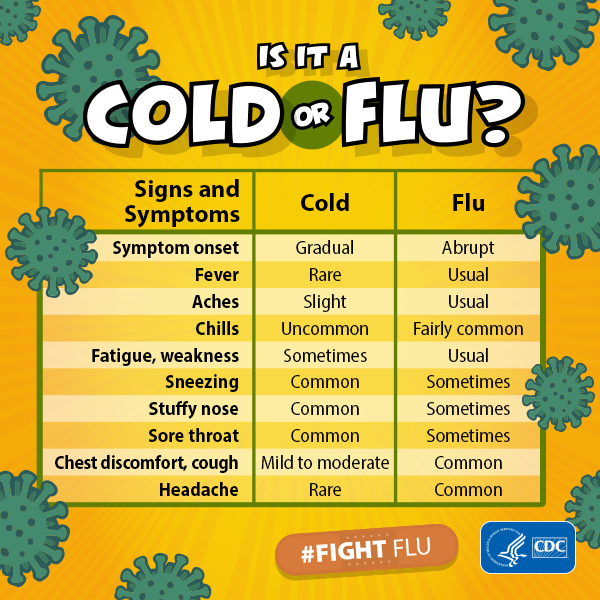While seasonal influenza (flu) viruses are detected year-round in the United States, flu viruses are most common during the fall and winter. The exact timing and duration of flu seasons can vary, but influenza activity often begins to increase in October. Most of the time flu activity peaks between December and February, although activity can last as late as May.
People with flu can spread it to others up to about 6 feet away. Most experts think that flu viruses spread mainly by droplets made when people with flu cough, sneeze or talk. These droplets can land in the mouths or noses of people who are nearby or possibly be inhaled into the lungs. Less often, a person might get flu by touching a surface or object that has flu virus on it and then touching their own mouth, nose, or possibly their eyes.
In addition to flu viruses, several other respiratory viruses also circulate during the flu season and can cause symptoms and illness similar to those seen with flu infection. These respiratory viruses include rhinovirus (one cause of the “common cold”) and respiratory syncytial virus (RSV), which is the most common cause of severe respiratory illness in young children as well as a leading cause of death from respiratory illness in those aged 65 years and older.
Most people get colds in the winter and spring, but it is possible to get a cold any time of the year. Symptoms usually include sore throat, runny nose, coughing, sneezing, headaches, and body aches. Most people recover within about 7-10 days. However, people with weakened immune systems, asthma, or conditions that affect the lungs and breathing passages may develop serious illness, such as pneumonia. Common colds are the main reason that children miss school and adults miss work. Each year in the United States, millions of people get the common cold. Adults have an average of 2-3 colds per year, and children have even more.
Prevention Tips
- Wash your hands often with soap and water. Wash them for at least 20 seconds, and help young children do the same. If soap and water are not available, use an alcohol-based hand sanitizer that contains at least 60% alcohol. Viruses that cause colds can stay on your hands, and regular handwashing can help protect you from getting sick.
- Avoid touching your eyes, nose, and mouth with unwashed hands. Viruses that cause colds can enter your body this way and make you sick.
- Stay away from people who are sick. Sick people can spread viruses that cause the common cold through close contact with others.
- Disinfect frequently touched surfaces, including objects such as toys and doorknobs.
Take time to get a flu vaccine.
- CDC recommends a yearly flu vaccine as the first and most important step in protecting against influenza and its potentially serious complications.
- While there are many different flu viruses, flu vaccines protect against the 3 or 4 viruses that research suggests will be most common. Three-component vaccines contain an H3N2, an H1N1 and a B virus. Four component vaccines have an additional B virus component. (See Vaccine Virus Selection for this season’s vaccine composition.)
- Flu vaccination can reduce flu illnesses, doctors’ visits, and missed work and school due to flu, as well as prevent flu-related hospitalizations.
- Flu vaccination also has been shown to significantly reduce a child’s risk of dying from influenza.
- Also, there are data to suggest that even if someone gets sick after vaccination, their illness may be milder.
- Everyone 6 months and older should get a flu vaccine every year before flu activity begins in their community. CDC recommends getting vaccinated by the end of October. Learn more about vaccine timing.
- For the 2019-2020 flu season, CDC and its Advisory Committee on Immunization Practices (ACIP) recommend annual influenza vaccination for everyone 6 months and older with any licensed, age-appropriate flu vaccine (inactivated, recombinant or nasal spray flu vaccines) with no preference expressed for any one vaccine over another. (See Types of Flu Vaccines).
- Vaccination of high risk persons is especially important to decrease their risk of severe flu illness.
- People at high risk of serious flu complications include young children, pregnant women, people with chronic health conditions like asthma, diabetes or heart and lung disease and people 65 years and older.
- Vaccination also is important for health care workers, and other people who live with or care for high risk people to keep from spreading flu to them.
- Infants younger than 6 months are at high risk of serious flu illness but are too young to be vaccinated. Studies have shown that flu vaccination of the mother during pregnancy can protect the baby after birth from flu infection for several months. Additionally, people who live with or care for infants should be vaccinated.

